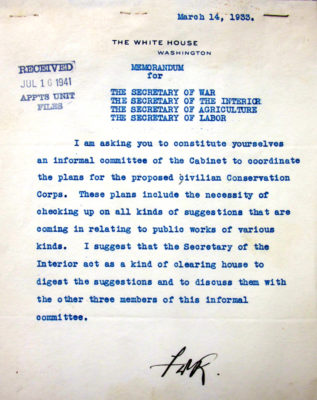By the 5th day of his first term, Franklin Delano Roosevelt (FDR), 32nd US President was setting in motion what is now recognized as the “single greatest conservation program in American history”. The Civilian Conservation Corps – CCC . It would become the first and most successful of the New Deal work programs.
By the 1oth day FDR signed four memos with a simple directive – “coordinate the plans”. The memos were addressed to members of his cabinet. George H. Dern, Secretary of War, Harold L. Ickes, Secretary of Interior 1933-1946, Henry A. Wallace, Secretary of Agriculture and Frances Perkins, Secretary of Labor 1933-1945.
This historic memo gave the four cabinets members powerful authority and a daunting task . . . they were to investigate and draft legislation which would allow the immediately implementation the first of the New Deal work programs, the Civilian Conservation Corps (CCC).
So much was riding on this untried idea.
Admittedly, it was an exciting research day finding this original memo tucked within the Civilian Personnel Records of Harold L. Ickes, Secretary of Interior at the St. Louis NARA. President Roosevelt knew what he was suggesting was actually an experiment, but he saw the need and was willing to try anything during those first one hundred chaotic and exciting days of his presidency.
The memo’s appearance is rather plain. A small piece of paper, half letter size and the printing at the top designating its place of origin – The White House, Washington has a flat type, not embossed. Certainly not the better, heavyweight stationery used for more official correspondence. At some point, perhaps before it was permanently filed away, it was stapled three times and stamped July 16, 1941.
Adding to the excitement of accessing this decades old memo was the reality of hindsight and knowing what happened next.
During the spring of 1933, FDR’s cabinet members consulted with other other advisors and outlined a master plan. They devised legislation which brought multiple government agencies together, like never before or since. It was a cumulative effort with unprecedented speed that got the first CCC camps up and running within weeks. The program was initially titled the Emergency Conservation Works (ECW), but was later changed to FDR’s preferred title – the Civilian Conservation Corps (CCC).
Fortunately, Harold L. Ickes had the wisdom to save the memo and during the ensuing years it was not purged from his official files.
Within a few months of organizing the CCC, FDR’s favorite New Deal program, is was clear the public response was overwhelming positive. This bode well when another related work program was being considered by FDR and his inner circle; one that would send unemployed artists into the CCC camps to make a pictorial record.
It would come to be known as the CCC art project, but that’s another story. . . .
